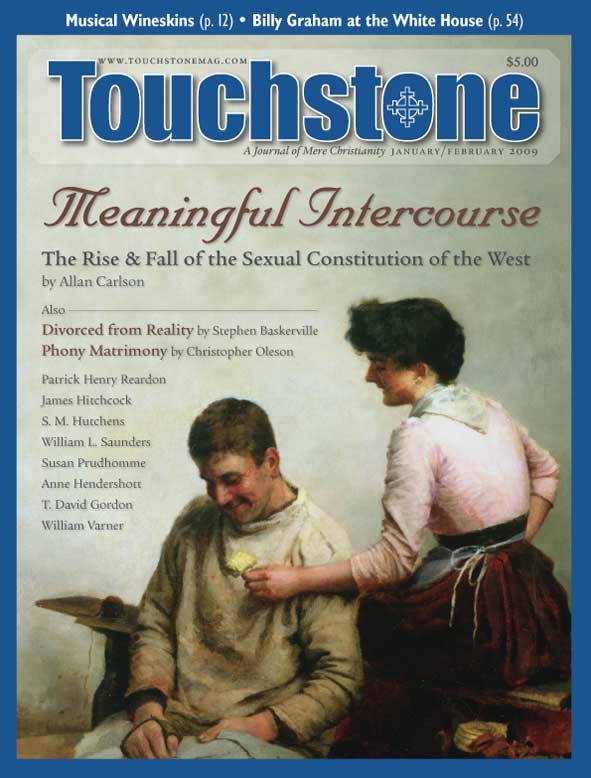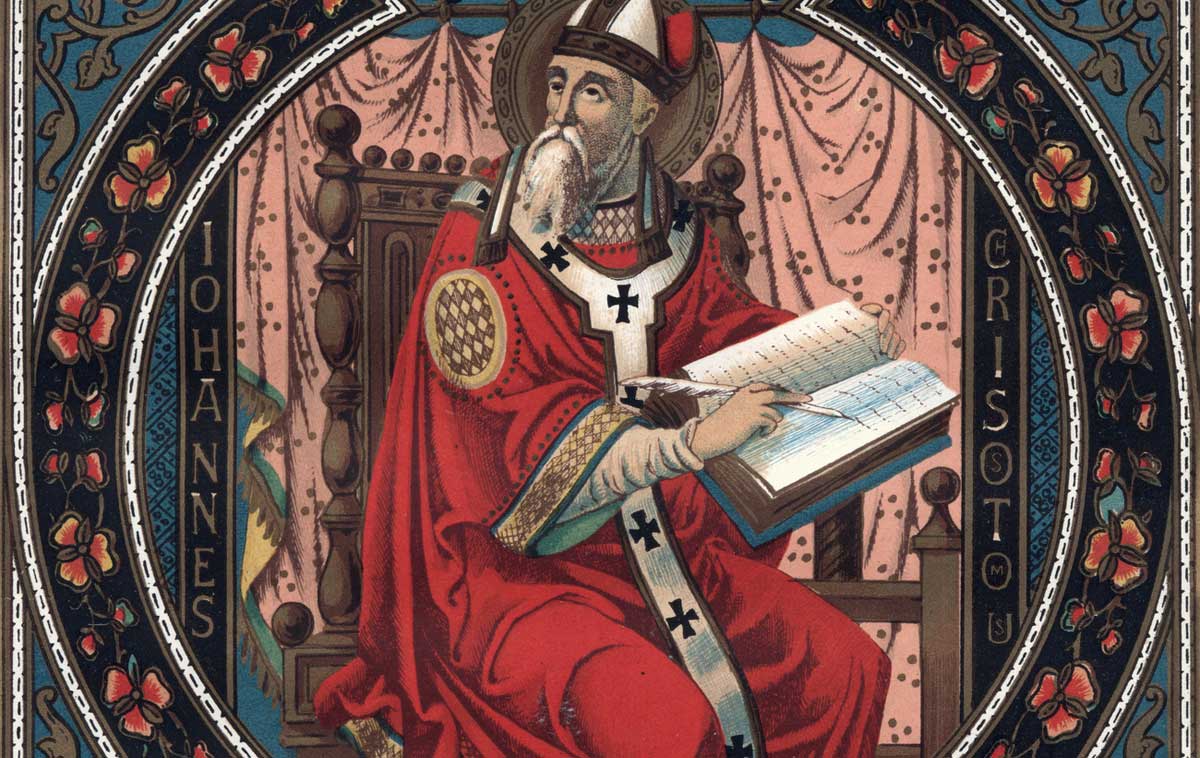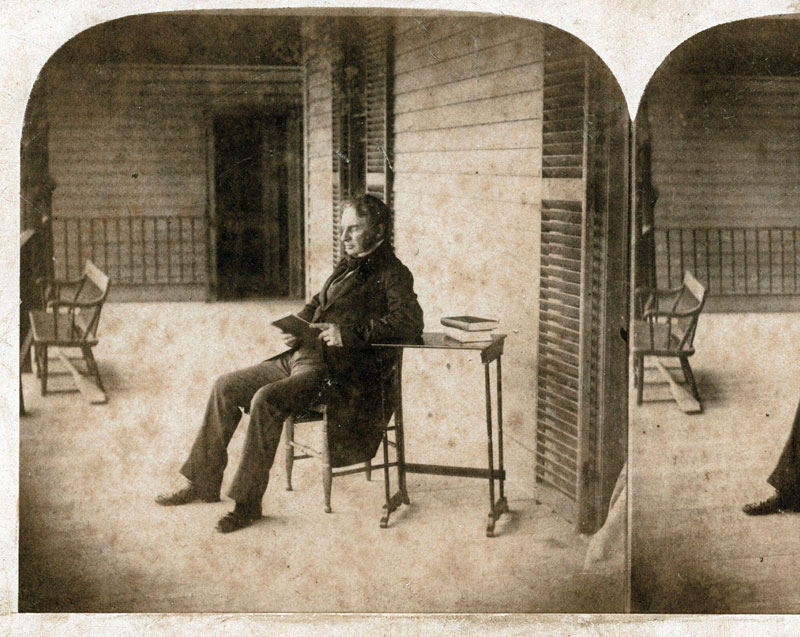Phony Matrimony
Or What King Kamehameha II Teaches Us About the Last Marriage Taboo
by Christopher Oleson
Last year’s decisions by the state Supreme Courts of California and Connecticut ruling it unconstitutional to prevent same-sex couples from entering fully into a legal marriage got me thinking again of Alasdair MacIntyre’s remarkable 1981 book, After Virtue. In that work MacIntyre makes the persuasive case that our contemporary moral vocabulary is at root unintelligible and arbitrary in much the same way that the Polynesian taboo precepts were before King Kamehameha II abolished them in 1819.
The remarkable thing about those taboo rules, MacIntyre noted, was that, over the course of time, their original significance and rationale had disappeared from the understanding of the Hawaiian islanders, while their observance remained in place. There was something unique, but inscrutable, about “taboo” prohibitions. They did not simply mean “forbidden.” Other things were forbidden, but not taboo. And yet, to the astonishment of a visitor like Captain Cook, no member of that island society seemed able to explain what exactly specified something as taboo, and why.
The society’s loss of the meaning and conceptual foundation of its moral vocabulary made it fairly easy for Kamehameha II to abolish the whole Hawaiian taboo system without much consequent upheaval in Polynesian society. For in reality, the Hawaiians had not actually been living by the original taboo precepts but by some remote and conceptually degenerate relic of them. The persistence of only a fragmented vestige of an originally larger whole left the opaque system of rules incapable of providing reasons for its demands. Thus, to borrow a line from T. S. Eliot, the hollow world of taboo prohibitions came to an end, not with a bang, but with a whimper.
Unfortunately for us, the moral language and practice of contemporary Western societies have, for quite some time, been in a condition uncannily similar to that of the early nineteenth-century Polynesians. In particular, our present vocabulary and customs concerning marriage seem to be entering that stage at which their long-standing rupture from marriage’s natural and original significance is provoking the monarchical abolition of now arbitrary “taboos” that can no longer be made sense of.
To put it more bluntly, traditional marriage as a public and cultural institution has not existed in our society for quite some time. What mainstream America, both conservative and liberal, religious and secular, has been and is now calling “marriage” is not really marriage, but a kind of contractually formalized “couplehood.” We have maintained the term “marriage” as an esteemed and protected word, but what that word once signified has lost its public existence within our culture. This is, of course, a highly distressing thesis, and, on the surface, it may seem an implausible one. Unfortunately, it is nevertheless true.
Procreative & Indissoluble
The older understanding of marriage, philosophically rooted in the natural law and historically embodied in the Christian tradition, included clear and unique qualities that specified a relationship as a marriage. The first and most obvious of these defining characteristics was that marriage was the singular place of appropriate sexual intimacy, and that this was always between one man and one woman. Classical natural law teaches that the actualization of our sexual faculties outside of this union is contrary to their natural, healthy, and humanly fulfilling end.
Yet even more important for the purposes of our discussion is the specific way in which this sexual uniqueness is to be actualized. The sexual union that is the singular gift of married life is always to be open to the generation of new life. Sex has natural purposes that must be respected if we are going to live life according to the Author of our nature. Chief among these is the generation of a family. Thus, at the heart of the marital covenant is, first, the inextricable intention to bring forth a family and, second, the commitment never to sunder one’s sexual life from that significance.
This is not to say that every act of unitive sexual intimacy must aim at procreation. It only means that spouses are not deliberately to frustrate the procreative significance of their sexual faculties. Thus, the deepening of their intimacy and union that is also effected through the conjugal act is never to be divorced from the procreative significance of that act. By nature, then, to choose sex is to choose marriage, and to get married is to choose to have children. It is this intrinsic ordination toward procreativity that makes marriage naturally between only a man and a woman.
There are many who honestly question the adequacy of this understanding of marriage, based on the fact that some marriages are validly entered into where there is little or no possibility of a child issuing forth from the union. One thinks of marriages between those who are beyond normal childbearing age. Or one may wonder about a woman who has had a hysterectomy. Is she no longer able to get married because conjugal intercourse with her husband could not be procreative?
The short and obvious answer is “Of course not.” In such cases there is true marriage even if the spouses are unable to realize all of the ends that God naturally intends for conjugal life. The reason for this distinction is that the spouses have not chosen to render their marriage infertile. Rather, time, disease, or some other infirmity of the body has made procreation impossible for them.
In other words, the cause of their marriage not embodying the full procreative purpose intended by God does not reside in their will, but in some external circumstance beyond their control or desire. Such couples are doing everything within their power to conform to and participate in the natural and divine significance of marriage. Their life together manifests as much of the reality of life-giving conjugal love as their bodies are able to give, and thus, there is nothing morally deficient about their union.
Following from the principle that bringing forth a family is of the essence of marriage, the perennial natural-law understanding articulated another fundamental defining quality of the marital union, its indissolubility. Because the nature of marriage is to bring forth children, a man and woman through that act are meant to become permanently united to each other in the “one flesh” of their child.
In marrying, a husband and wife intend this irrevocable bond, and the child is, in turn, a source of strength to a union whose claim is larger than their subsequent emotions and fluctuating feelings. Their life becomes mutually invested in their children and grandchildren. They uniquely share what is most crucial and important in their lives. Thus, inextricable to the intention to marry is the intention never to be united to another in marriage so long as one’s spouse is alive. This is the meaning of “till death do us part.”
Contemporary “Marriage”
It does not take much reflection to see that our society’s understanding and practice of marriage does not correspond (and, for some time, has not corresponded) to either of these essential elements of the marriage bond. Whether you’re chatting with Bobos at the nearest Starbucks, listening to conservative talk-show hosts, or attending a wedding at a local Evangelical church, there is a discernable near-unanimity regarding marriage that underlies the public disputes over who can enter into it.
What are these core assumptions that are commonly embraced by mainstream American society, both conservative and liberal? The most commonly recognized ingredients of a marriage are a man and a woman who are in love with each other and want to be with each other for the rest of their lives. They seek a public recognition of that love and commitment. There need be no doubt that most of the time there is complete sincerity on both sides about wanting to make a life-long run of it “till death do us part.”
Children Optional
However, two other cultural assumptions stand out as highly significant and socially defining to the contemporary understanding of marriage. The first is that children are commonly thought to be an attractive but supplementary add-on to a marital relationship. In other words, the intention to have children is not seen as of the essence of what it means for two people to be getting married. Children are considered accidental and posterior to the union.
“Yes, of course we eventually want children. But we’ll decide about all that later.” Or “Having children at some time is attractive to us, but we haven’t made any final decisions about it.” Or simply, “We’re not sure whether or not we want children.” None of these sentiments raises so much as an eyebrow in our society because marriage and the intention to have children are taken to be quite distinct decisions in our cultural outlook.
Added to this is the fact that using contraception is taken to be about as controversial in our society as brushing one’s teeth. Almost no one regards acts of sexual intimacy, whether in or out of marriage, as intrinsically procreative in nature. For most, sex is simply delightful play, uniquely appropriate for expressing one’s romantic feelings, and it also happens, as it were, to be the most useful way to have a baby.
It is true that many in our culture recognize that this play is quite serious, involving deep emotional implications, and therefore not to be entered into lightly. But that its procreative potential must always be respected is one of the most countercultural beliefs a person can hold.
A Revocable Contract
The second cultural assumption has to do with the intentionality with which a couple enters the marital union. Assuredly, they want to be together for life, but if you press deeply enough, you will discover that almost everyone still allows for the (remote and undesired) possibility that, should things not work out, another marriage to a different spouse is still theoretically possible. In other words, there are certain conditions attached to the union. Should the unthinkable happen and one or both of the spouses become miserable with little prospect of amelioration, divorce and re-marriage would be acceptable.
Even if one does not envision this happening to himself, still it is generally taken as a given that others should be able to find a new spouse who, this time, will make them happy. In other words, American society does not regard marriage as an indissoluble relationship. It is a revocable contract and ultimately may be dissolved and then entered into with a new party.
It is true that in almost all circles of American society, there is still a strong sense of the propriety and desirability of lifelong marriage. But the actual belief and frequent practice of mainstream American culture, conservative and liberal alike, is that a “do over” is always possible. Pick a conservative Evangelical church at random out of the phone book. Go visit it, observe its practices, and you will see that it re-marries members of its flock, sometimes repeatedly, albeit recognizing the painful “failure” that resulted in the divorce of the previous and supposedly “Christian” marriage. I’m not saying that this is unfailingly the case. It is only overwhelmingly the case.
Even in the Catholic Church, which is the only major institution in the Western world whose core doctrine preserves the procreative and indissoluble nature of marriage, there is an ongoing annulment crisis that reveals a widespread inadequacy in the way in which couples are being prepared to enter into the covenant of marriage. It would appear that a great many of the church’s ministers are either unwilling or incapable of forming in their laity a proper understanding of what it means to unite oneself to another in this sacrament. For far too many, it seems, a “Catholic” marriage ceremony ends up being a public contractualizing of one’s couplehood in front of a priest.
If this is in fact what many Catholic couples are doing, but just doing it in a building that “feels” solemn and spiritual to them, then it is not surprising that a scandalously large number of declarations of nullity are being granted by church marriage tribunals. These people have not, in fact, gotten married, for marriage is a sacrament instituted by God, and as such, the covenant cannot be entered into without the proper intentionality on their part.
If the surrounding culture gives a couple no indication of what they are supposed to be intending, but, on the contrary, profoundly distorts the meaning of the union they are seeking, and if their Christian community has either forgotten or failed to communicate the nature and conditions intrinsic to this exalted state of life, how can we possibly expect men and women to embrace something they’ve scarcely seen or heard of?
Contractual Couplehood
So where does all of this leave us? What does it mean when seen in light of the original significance and nature of marriage? It means, first, that our society has preserved the label “marriage” while having lost almost all living contact with what that word originally and essentially signified. When a modern American couple, oblivious as they are to the procreative and indissoluble nature of the marital covenant, goes to the altar or courthouse and commits to living together for life, they are not actually getting married in the original sense of that word. They are entering into a contractually formalized “couplehood.”
This does not mean that their love and commitment do not deserve a great deal of respect, or that their life together is a joke to be treated with levity. It only means that our cultural deterioration has largely deprived them of the opportunity to enter into that kind of union that used to be uniquely labeled “marriage.”
It is its indissolubility and intrinsically procreative purpose (which latter element, again, makes it naturally between a man and woman) that make this relationship marriage. Because neither of these is customarily regarded by our society as of the very essence of marriage, marriage does not really have a public life in our culture. What passes for marriage in the Western world these days, both in terms of our cultural sensibilities as well as in law, is what I described above, namely, two people who are really crazy about each other and want to be a “couple” for life.
Typically, this vision is not repudiated even by more conservative Americans with “traditional values.” The only thing that the latter usually add to this understanding is that one should refrain from sexual relations until he has entered into that relationship.
The problem with this “conservative” acceptance of our culture’s understanding of marriage as contractual couplehood is that two men or two women can also fit this description. A same-sex couple can be just as sincerely crazy about each other, committed to being together (hopefully) for life, and desirous of a public recognition of that commitment. Exactly like the heterosexual married couple, they regard the question of children as fundamentally unrelated to their initial commitment to their relationship, and may equally see the idea of later having a different spouse as an unattractive, highly remote, but nevertheless real possibility.
Logical Inconsistency
Which brings us back to the nineteenth-century Polynesians and King Kamehameha II. It strikes me that the fate of our moral language and practice is not likely to be different from theirs, for there is a certain inevitability, and even a logical consistency (given our societal commitments), to demands for recognition of same-sex marriage. Mainstream American society, even as it is statistically somewhat more opposed to same-sex marriage than in favor of it, envisions “marriage” in a way that cannot bear any rational scrutiny of its exclusion of same-sex couples. Indeed, a consistent thinker must be sympathetic to the latter’s situation. Such couples justifiably sense that they are being arbitrarily discriminated against, given what American society understands “marriage” to signify.
What is the rational difference, after all, between a heterosexual couple who marry with no intention of having children, engage solely in non-procreative sexual activity, and regard their union as dissolvable, on the one hand, and a same-sex couple who marry with no intention of having children, engage solely in non-procreative sexual activity and regard their union as dissolvable?
The answer is: there is no rational difference. Both are a non-marital coupling of sexually de-gendered and bodily homogenized selves contractually (and thus conditionally) seeking mutual fulfillment. Both equally fit within our society’s fundamental presuppositions about “marriage.” Yet we are somehow supposed to be okay with the former but aghast at the latter?
The usual reason offered for this repugnance by traditional defenders of heterosexual couplehood is the statistically higher rate of promiscuity and lower level of commitment among gay men. While this sociological fact may be true, we need to be careful here. Such observations do not of themselves yet provide us with a consistently rational measure for forming public policy, and as such constitute a grave argumentative misstep in this political discussion.
These statistics, for what they’re worth, are an indication that something is wrong, but they are not an explanation of what is wrong. These social phenomena are an effect, not the cause. One can find plenty of heterosexual men (and women) who are deplorably uncommitted. Simply look at our divorce rate, or the rate of separation among cohabiting heterosexual couples, or the percentage of “straight” people who engage in casual and deviant sex. Are we going to base marriage law on a sociological statistic of commitment level? What will our cutoff be, and how will we exclude same-sex couples who have been committed to each other for years?
It would be preposterous to say to homosexual couples, “Although heterosexual couples in general are making a huge botch of marriage and are generally failing to live by the true meaning of sexual union, and although their level of divorce and infidelity is shockingly high, neverthless research shows that you guys are generally making an even bigger botch of it.” This is not a convincing line of reasoning, to say the least.
Moreover, I would be hard pressed to concede that the degree of promiscuity among gay men noticeably surpasses the level desired and pursued by typical heterosexual pagan frat boys, who probably outnumber gay men ten to one. The tyranny of the libido seems to be just about as totalitarian among that demographic as among gay men. It is unreasonable for us to harp on the destructive sexual activity among gay men and simultaneously ignore the Bacchanalia engaged in on a weekly basis by today’s American high-school and college students.
The only point I am trying to make here is that we cannot fall into the temptation, especially given our highly pornotopian culture, of tendentiously viewing homosexual couples as abstractions of singular sexual deviancy. If one bothers to look, one will find among such people those who rush their loved ones to the hospital, lose hours of sleep providing nurture and care, and help each other grieve through the loss of a father or mother. Far from being morally problematic, these kinds of habits and commitments are praiseworthy in human relationships.
Obviously, commitment and sacrifice of this kind cannot itself be what is objectionable in such unions, otherwise we would have a very paltry understanding of friendship (of which, as St. Thomas Aquinas tells us, marriage is a species). If, therefore, there is something wrong with such a public union, it must reside in the uniquely sexual nature of the marital relationship. And yet it is precisely here that the conservative defenders of “marriage” are entirely without rational resources.
The Same Moral Principle
What traditionally minded defenders of life-long heterosexual couplehood are left to object to is either (1) that homosexual behavior is “yucky” (an instinctual and, by itself, sub-rational repugnance) or (2) that the Bible simply happens to anathematize such behavior (as though God arbitrarily thundered prohibitions without reason and without reference to the goods which human nature is meant to realize). Neither one of these objections provides a rational understanding of why such behavior could be morally problematic or why God would forbid it. They are therefore not only justifiably open to the charge of being intellectually hollow, but constitute a recipe for a public routing in the marriage debate.
The truth of the matter is that the ultimate reason why homosexual acts are contrary to human nature (namely, that they violate the generative purpose of sexual union) is the same reason why contraceptive heterosexual sexual activity is unreasonable behavior. They stand or fall together.
This is not to say that one is not more contrary to nature than the other, or that it is not easier to see one as more contrary to nature than the other. There is certainly a gradation of moral gravity in the ways in which human sexuality is deprived of its due ordination toward its natural end. Thus, St. Thomas speaks of the “vice against nature” as the greatest sin among the various species of lust.
Nevertheless, St. Thomas lists four different acts under the “vice against nature,” not merely homosexual intercourse. Masturbation, “undue” (i.e. contraceptive) intercourse, and bestiality, although specifically distinct and distinctly grave acts, are also treated under the same general vice because their immorality commonly derives from the fact that they all corrupt the same principle—namely, the generative end of human sexuality.
Thus, St. Thomas sees what most conservative Americans do not seem to be able to see anymore, namely, that although these acts differ in the degree to which they gravely corrupt the order of nature established by God, nevertheless, each of them is wrong based on its common violation of the same moral principle. Accordingly, most traditionally minded members of our society seem to be maintaining the ban on same-sex “marriage” as the Polynesians held fast to their “taboos,” which is to say, arbitrarily—because they have ruptured the ban from the original reason for it.
This is not to say that such people are personally to be blamed for practicing a conservative version of couplehood. Our cultural deterioration is quite advanced, and it affects and wounds all of us in some way or another without our fully understanding it.
Nor is it to be said that our society’s more visceral instincts about male-female complementarity are not rooted in a natural and sound, albeit inarticulate, intuition. Unlike many of the Polynesian taboos (such as men and women not eating together), ours forbidding the violation of gender complementarity in marriage is ultimately rooted in a natural human good. Thus, the demise of this taboo in our society is ending with a little more bang than whimper (as evidenced, for example, by the success of the recent constitutional referendum in California).
Clandestine & Countercultural
Nevertheless, it remains the case that mainstream American culture (conservative included) can at present offer no rational basis for its taboo on same-sex “marriage,” and this is why we are steadily succumbing to the abolitions of the self-proclaimed Kamehamehas reigning in the judiciary. Judges are taking on the imperious role of purging our moral customs of the unintelligibility and incoherence that they possess because of the degeneration of meaning that has occurred under the continuity of an enduring vocabulary word. They are putting the legal coup de grace on the last vestiges of our moral customs whose exclusions have become rationally baffling because they bear no present relation to the original significance that engendered them.
If we are truly to defend marriage in this country, and not the contractual couplehood that has for some time now been disguising itself as “marriage,” then it is imperative for us to recover the full meaning of that beautiful covenant whose embodiment is now clandestine and highly countercultural. This will, I think, have to be done from the ground up, and it will take generations to succeed, if in fact it succeeds at all. It will have to be lived out first in small communities that embrace and support the self-giving, procreative, and indissoluble nature of that union, and who do so not as an unjustifiable exclusion, but as a positive commitment to protect such an important, difficult, and beautiful undertaking.
The commitment to recovering the natural meaning of conjugal life need not make one any less humane toward those who misconstrue it or who have tragically fallen short of it. But perhaps this is only another way of saying what MacIntyre said in concluding After Virtue, when he called for the “construction of new forms of community within which the moral life could be sustained, so that both morality and civility might survive . . . through the new dark ages which are already upon us.”
Post This!
Through a resolution adopted at its Lambeth Conference in 1930, the Anglican Church became the first Christian body to formally approve the use of contraceptives. In an editorial published on March 22, 1931, the Washington Post had this to say in response:
It is impossible to reconcile the doctrine of the divine institution of marriage with any modernistic plan for the mechanical regulation or suppression of human birth. The church must either reject the plain teachings of the Bible or reject schemes for the “scientific” production of human souls. Carried to its logical conclusion, the committee’s report, if carried into effect, would sound the death-knell of marriage as a holy institution, by establishing degrading practices which would encourage indiscriminate immorality. The suggestion that the use of legalized contraceptives would be “careful and restrained” is preposterous.
Marriage & Friendship
While I heartily agree with Christopher Oleson that we would not now be arguing about homosexual pseudogamy had heterosexuals themselves retained a sense of the holiness of marriage and the centrality of procreation to the marital act, I would not like to concede that tolerance of one error (contraception, let us say) leads with inevitable logic to tolerance of homosexuality generally.
If a husband and wife engage in the marital act while attempting, in that same act, to thwart the act’s meaning and its natural fulfillment in conception, they are doing what is in itself a holy thing, in the wrong way, and for the wrong ends or at least for a badly reduced end. But two men cannot engage in the marital act at all; they cannot, as our senior editor Robert George points out in The Clash of Orthodoxies, become the one-flesh organism that alone can naturally beget and conceive a child. Their sexual relations can only parody that act; they are wrong then in themselves, and not by circumstance.
The intrinsic unnaturalness of the act should cause us to ask whether marriage is the only good thing that, in itself, it corrupts. I’d reply by agreeing again with Oleson that a prior corruption of marriage is a precondition for our tolerance of the sin of Sodom.
But in the case of a man and a man committing that sin, or a woman and a woman, I affirm that what is being corrupted in turn is not marriage, or at least not marriage in the first instance. It is, as I’ve written in these pages, same-sex friendship, especially among boys. For their sake, to foster intimate and powerful friendships free of the possibility of being misunderstood, or stifled to avoid misunderstanding, I should oppose homosexual pseudogamy, regardless of the mire into which the sins of heterosexuals have driven us.
— Anthony Esolen
The article referred to, “A Requiem for Friendship,” is from the September 2005 issue and can be found online in the Touchstone Archives.
subscription options
Order
Print/Online Subscription

Get six issues (one year) of Touchstone PLUS full online access including pdf downloads for only $39.95. That's only $3.34 per month!
Order
Online Only
Subscription

Get a one-year full-access subscription to the Touchstone online archives for only $19.95. That's only $1.66 per month!
bulk subscriptions
Order Touchstone subscriptions in bulk and save $10 per sub! Each subscription includes 6 issues of Touchstone plus full online access to touchstonemag.com—including archives, videos, and pdf downloads of recent issues for only $29.95 each! Great for churches or study groups.
Transactions will be processed on a secure server.
more on marriage from the online archives
more from the online archives
calling all readers
Please Donate
"There are magazines worth reading but few worth saving . . . Touchstone is just such a magazine."
—Alice von Hildebrand
"Here we do not concede one square millimeter of territory to falsehood, folly, contemporary sentimentality, or fashion. We speak the truth, and let God be our judge. . . . Touchstone is the one committedly Christian conservative journal."
—Anthony Esolen, Touchstone senior editor












